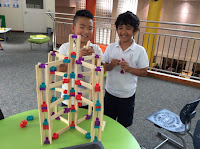PROFESSIONAL DEVELOPMENT
JANUARY 5TH, 2017
Task 2 - Mindset
In our PD lesson about mindset, we focus more on what it's called 'Growth Mindset".What is growth mindset all about?
Growth mindset is the belief that qualities can change and that we can develop our intelligence and abilities. There are two types of mindsets. Fixed mindset and growth mindset.
Here is the chart showing the different between these two mindsets.

Growth mindsets are as follows:
- Intelligence isn't fixed but something that can grow and can be developed.
- Challenge your brain can increase your intelligence and make it stronger.
- Students with growth mindset focus on learning over just looking smart. They see effort has the key to success and thrive in the face of a challenge.
- Growth mindset leads to a desire to learn, embrace challenges, persist in the face of setbacks and learn from criticism.
- They find lessons and inspiration in the success of others. As a result, they reach even higher.
https://youtu.be/Yl9TVbAal5s
The research shows that we should praise students for their effort, strategies, focus, persistence - not their intelligence.
Praising intelligence encourages a fixed mindset while praising effort, strategies, focus and persistence encourages a growth mindset.
As educators, it is our task to create a growth mindset classroom. In the safety of these classrooms, students can begin to leave behind their fixed mindset and try out the idea that they can develops their abilities.
These can only happen when Teachers give students:
- Meaningful work
- Honest and helpful feedback
- Advice on future learning strategies
- Opportunities to revise their work and show their learning
"The best thing we can do is to teach children to love 'challenges, be intrigued by mistakes, enjoy effort and keep on learning."






















